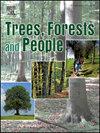Influence of stand characteristics and management activities on aboveground carbon storage in Japanese cedar and cypress plantations: Sustainable management implications
IF 2.7
Q1 FORESTRY
引用次数: 0
Abstract
Tree plantations substantially sequester carbon in aboveground biomass and soil and serve as an alternative to forests in mitigating global warming. This study investigated the relationship between aboveground carbon and stand characteristics and management activities in two Japanese plantations (cedar and cypress) for their sustainable management viewpoint, which has not been studied before. Aboveground carbon stock ranged from 3.96 to 248.53 Mg C ha-1 in 9- to 188-year-old Japanese cedar and 7.09 to 119.17 Mg C ha-1 in 11- to 129-year-old Japanese cypress plantations. Annual aboveground carbon storage differed significantly between the two species. Aboveground carbon storage in Japanese cedar was affected by stand characteristics (e.g. soil moisture, electrical conductivity, soil texture especially sand and clay, site quality, and stem density) and management activities (e.g. initial silvicultural practices, stem exclusion practices, pest and wildlife management and land management). However, the same in Japanese cypress was affected by stand characteristics (e.g. soil moisture, electrical conductivity, soil texture especially sand, bulk density, site quality, stem density, and elevation) along with management activities (e.g. initial silvicultural practices, stem exclusion practices and land management). Therefore, continuous monitoring and periodic assessment of the stand characteristics and management activities may be taken into consideration in future policy-making decisions to promote aboveground carbon storage and climate change mitigation ability of these plantations in Japan on a sustained basis.
林分特征和管理活动对日本杉木和柏木人工林地下碳储存的影响:可持续管理的意义
植树造林能在地上生物量和土壤中大量固碳,是减缓全球变暖的森林替代品。本研究调查了日本两种人工林(杉木和柏木)的地上碳与林分特征和管理活动之间的关系,以了解其可持续管理观点,这在以前的研究中还没有过。树龄为 9 至 188 年的日本雪松的地上碳储量范围为 3.96 至 248.53 兆克碳/公顷-1,树龄为 11 至 129 年的日本柏树的地上碳储量范围为 7.09 至 119.17 兆克碳/公顷-1。两种树种的年地上碳储量差别很大。日本柏的地上碳储量受林地特征(如土壤湿度、导电率、土壤质地(尤其是沙土和粘土)、场地质量和茎干密度)和管理活动(如初始造林措施、茎干排除措施、虫害和野生动物管理以及土地管理)的影响。然而,日本柏的相同点则受到林分特征(如土壤湿度、导电率、土壤质地(尤其是沙土)、容重、场地质量、茎干密度和海拔)以及管理活动(如初始造林措施、茎干排除措施和土地管理)的影响。因此,在未来的决策中,可以考虑对林分特征和管理活动进行持续监测和定期评估,以持续促进日本这些人工林的地上碳储存和减缓气候变化的能力。
本文章由计算机程序翻译,如有差异,请以英文原文为准。
求助全文
约1分钟内获得全文
求助全文
来源期刊

Trees, Forests and People
Economics, Econometrics and Finance-Economics, Econometrics and Finance (miscellaneous)
CiteScore
4.30
自引率
7.40%
发文量
172
审稿时长
56 days
 求助内容:
求助内容: 应助结果提醒方式:
应助结果提醒方式:


